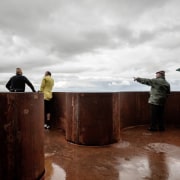A long and rustic road
Cycle/pedestrian Chemin des Carrières, or quarries track, is a meandering trip through history, landscapes, towns and the odd arresting sculptural feature along the way. Much of the walkway is in Corten steel, a tactile evocation of the quarry railway of years gone by
Designed by Reiulf Ramstad Arkitekter
From the architects:
Chemin des Carrières, the Quarries’ Track, is a Corten steel ribbon meandering through the landscape – a rustic invitation to pushbike or walk and explore the reconquest of the Rosheim-St Nabor railway in Alsace, France.
Overgrown, sometimes hidden, the vestiges of the original railway still mark the reading of the site. The need to create a route to serve the quarries required adapting to the undulating landscapes of the sub-Vosges hills and the very form the Quarry Track traces tells the history of the landscape and the men.
The journey to discover forgotten landscapes or to take a different view on everyday landscapes is to be enjoyed by both local users and tourists. Like the old rail track that had offered a dual function (industrial and passenger transport), the new pedestrian route has a double vocation practical access and tourism.

The 11km path is likened to a story, which the stops split into five chapters of different sequences of landscapes offering varied outlooks and highlighting remarkable sites. Unusual elements punctuate the pedestrian track, aiming at awakening the visitor’s senses. For example, the sight, sound and smell of clear water water is frequently encountered.
The “voie verte” – or green way – from Rosheimto Saint-Naboris not a bicycle path like any other. Several installations activate the walk-cycleway
Reiulf Ramstad created the many imposing metallic sculptures to connect with the industrial history of the various places encountered along the way. Similarly, objects evoking the life of the old railway, such as railway crossings or an old weighing scale, have been installed. All along the way, there are spaces inviting you to take a break and soak in the local history and the scenery.
Each place along the way has a point of character and difference.

Rosheim tells the story of the past
Shaped by intertwined circles in Corten steel, the Rosheim pavilion has a labyrinthine-like character and plays with irregular concave and convex interior forms, which visitors are free to explore.
The original train tracks are conserved in this area, benches have been introduced, and openings created to open or close the sculptural walkway to chosen views of the surrounding landscape – thus optimising viewing, seating, reflection and contemplation.
Boersch tells the story of water
Next the Quarries Track passes through the historic town of Boersch. The Le Weidasch river, which historically brought local connection to the wider world also reflects the true cleanliness of the town and vicinity. The river is a dynamic element in the landscape in this area so make the most of this natural asset, the architects enlarged the riverbed and build a large open space amphitheatre that provides easy access the water.
Leonardsau tells the story of the land
After travelling along a long green tunnel, two large Corten steel plates amplify the opening effect at you emerge from the end of the forest corridor to the open landscape. The plates symbolise a gate and direct your perspective towards Mont St-Odile, and are intended to evoke the idea of discovery.
Ottrott tells the story of travel
As well as being home to several historic castles, Ottrott includes a station stop on the historic Rosheim-St Nabor railway. The restored rail stop helps conjure the history of the railway through displayed heritage elements such as the rail bridge, crane, water pump etc.

Saint-Nabor tells the story of luck.
Closed for years and undergoing a "renaturalisation" process, the quarries symbolise the reconquest of the vegetation on a former industrial site. And it’s on one of the highest platforms in Saint-Nabor that the traveller discovers the most spectacular work: a promontory in Corten steel offering a wide view on the valley of Rosheim and the plain of Alsace.
From this viewpoint, inspired by a four-leaf clover, the visitor will indeed feel lucky to be taking in the sweeping views of such a beautiful territory.
Credit list
Architecture firm
Programme
Location
Client
Story by: Trendsideas
Photography by: Florent Michel
Home kitchen bathroom commercial design
Classic looks, contemporary efficiency
Personality plus
Diving into nature













